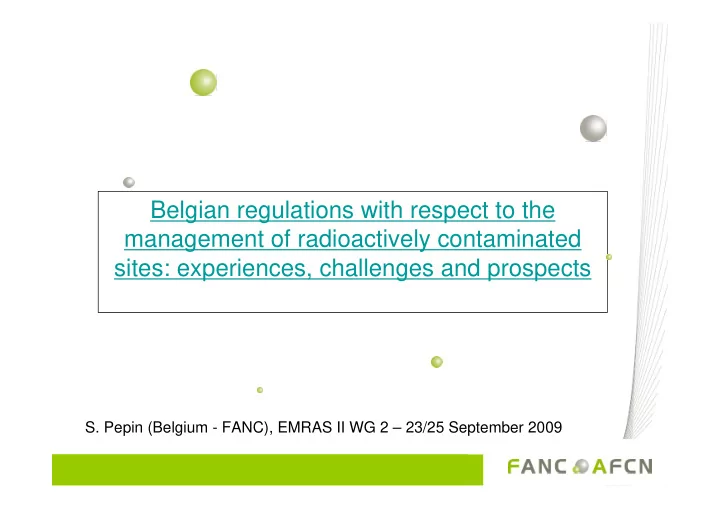

Belgian regulations with respect to the management of radioactively contaminated sites: experiences, challenges and prospects S. Pepin (Belgium - FANC), EMRAS II WG 2 – 23/25 September 2009
Overview of legacy / NORM sites in Belgium - Site of a former radium extraction plant (UMICORE): contamination of landfill site + riverbanks + streets (slags used in road construction) ⇒ between a few Bq/g till ~ 1 kBq/g. - Former Ferro-Niobium extraction facility (from coltan): landfilling of contaminated slags ⇒ contamination up to 60 Bq/g Th-232, 12 Bq/g U-238
Overview of legacy / NORM sites in Belgium (2) - Phosphogypsum / CaF 2 stacks (legacy + in operation) e.g. former PG stack: 0.5 – 0.6 Bq/g Ra-226 + radon flux measurements 62 mBq/(m² s) ⇒ Project by government to build a jail on site ! - Others: steel industry discharge sites (refractories, slags)
Current regulations: NORM activities General framework: directive 96/29/EURATOM Current NORM industries as « work activities » Transposed into Royal Decree of July, 20 2001 a) Positive list of work activities: - Phosphate industry - Zircon industry - Extraction of rare earths - Tin foundries - Production of thoriated welding electrodes Industries of these sectors compelled to make dose-assessment of workers + population b) FANC may define radon-prone areas: all workplaces located in radon- prone areas must be subject to Rn-monitoring
Current regulations: intervention General framework: directive 96/29/EURATOM « I nterventions in case of lasting exposure » « Where the Member States have identified a situation leading to lasting exposure resulting from the after effects of a radiological emergency or a past practice, they shall, if necessary and to the extent of the exposure risk involved, ensure that: (a) the area concerned is demarcated; (b) arrangements for the monitoring of exposure are made; (c) any appropriate intervention is implemented, taking account of the real characteristics of the situation; (d) access to or use of land or buildings situated in the demarcated area is regulated. » Transposed into Royal Decree of July, 20 2001 (Art. 72bis)
Challenges 1. Criteria for evaluation of necessity to intervention ? 2. Administrative procedure to apply ? 3. Who is liable for the intervention (investigations, remediation) ? 4. Rules for transfer of property, financing,… ? 5. Interaction with non RP regulations ?
New regulation under development Step by step administrative procedure 1. Orientation investigation ( validation of risk ⇒ contaminated grounds in a official register ) 2. Descriptive investigation ( assessment of radiological risk) 3. Pre-study over intervention/clean-up options ( choose the remediation strategy) + concertation with stakeholders 4. Clean-up or risk-management project ( elimination / control of risk) (risk-management = e.g. restrictions on the use of the grounds or monitoring program)
Liabilities 1 ° operator / user of the facilities located on the site where the contamination comes from; 2 ° if no operator/user, owner of the site where the contamination comes from. + in case of transfer of property of contaminated ground ⇒ obligation for the seller to inform the buyer (via register)
Technical criteria’s Technical recommandations: - “Generic content of an orientation or descriptive investigation” - “Intervention levels for lasting exposure situations” • dose < 0.3 mSv: never intervention • 0.3 < Dose < 1 mSv: intervention rarely justified • 1 < dose < 3 mSv: intervention generally justified • Dose > 3 mSv: intervention always justified
Interface with non-RP authorities • Radioactive contamination generally mixed with non radioactive contamination • Belgium: RP = competency of federal state / other environmental aspects = competency of Regions ⇒ Entangled regulations – need for consistency between RP regulations and regulations related to non radioactive contamination • Exchange of information between administrations: identification of potentially contaminated sites • Defining modalities of collaboration for concrete cases
Interface with non-RP authorities (2) Definition of common terminology : • For example: ⇒ Link between “NORM” positive list of RP regulation and European classification of economic activities - NACE codes (EC REGULATION No 1893/2006): e.g. code 23.20 “Manufacture of refractory products” ⇒ Link between “NORM” residues and European waste codes (2001/118/EC - Commission Decision as regards the list of wastes): e.g. 06 01 04* waste from the manufacture of phosphoric/phosphorous acid 10 01 02 coal fly ash, … Common methodology for risk-assessment: taking into account • radiological and chemical-toxical parameters as a whole in the decision-making process
What next ? In expectation new law (still to be approved at political level) ? Use of current regulations with respect to work activities: � Current work activities (e.g. phosphate industry) may be obliged to perform risk-assessment for their waste disposal sites � If radon = most important exposure pathway, NORM- contaminated site may just be considered as “Radon-prone area” (Rn of industrial instead of geological origin) ⇒ obligation of Rn-monitoring + prevention measures in building construction
Conclusions � Importance of collaboration with non RP authorities (regulatory and administrative consistency, exchange of information, coherence in the risk-assessement and in the decision-making process,…) � New regulations must still be approved politically (some “touchy” points: liability, transfer of property,…) � Current regulations on work activities (including consideration of contaminated sites as “radon-prone areas”) already allow some (limited) control of contaminated sites.
Conclusions � Many open issues ! • disposal of waste from remediation activities: regulatory status (radioactive waste or not ?) + acceptation criterias • definition of measurements protocol and quality assessment program • …
Recommend
More recommend